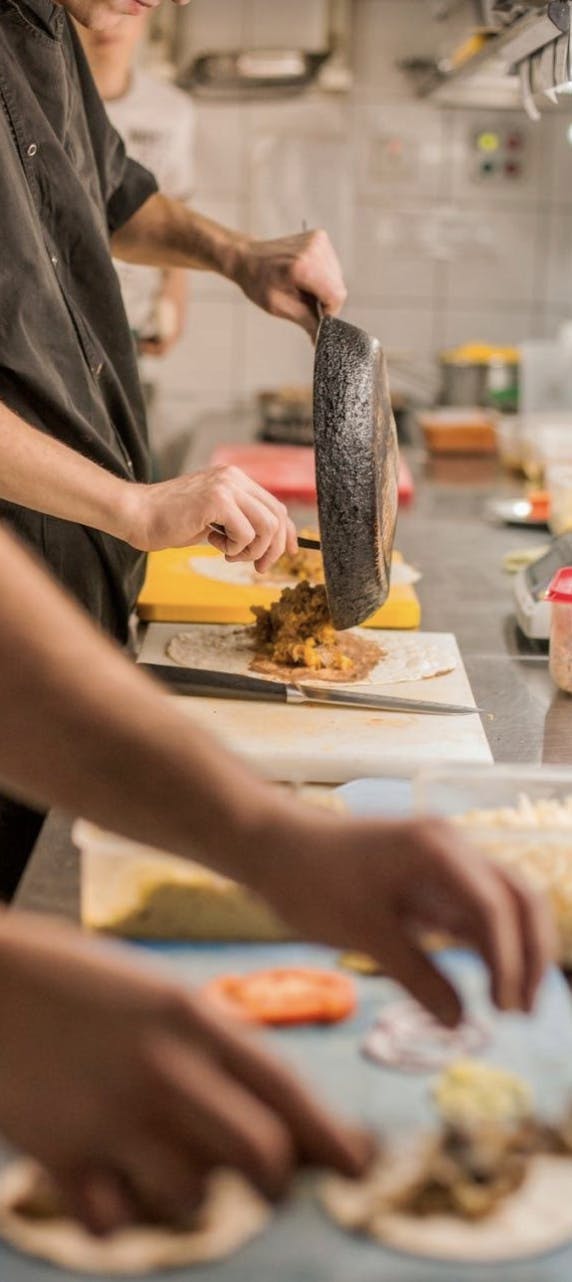Food trends in 2025: what you need to know to stay competitive
Table of Contents
CloudKitchens
How many tacos can be delivered from a 1000sqft restaurant?
The same amount as a 200sqft ghost kitchen.
As we approach 2025, the food and beverage industry is witnessing a transformative shift driven by changing consumer expectations, sustainability demands, and the rise of technology in food service.
For ghost kitchens and delivery-focused restaurants, staying ahead of these trends is essential to capture new markets, foster customer loyalty, and maintain a competitive edge.
By understanding the upcoming food trends, your ghost kitchen can adapt to new demands, meet customer preferences, and enhance operational efficiency.
Key food trends to expect in 2025
1. Plant-Based and Sustainable Ingredients
The plant-based movement has shifted from a trend to a fundamental change in consumer behavior. According to a Whole Foods Market report, 65% of Gen Z consumers want a more plant-based diet for environmental and health reasons.
By 2025, plant-based meat alternatives, dairy-free options, and a wide array of vegan-friendly ingredients will continue to expand. These choices are popular not just for health-conscious customers, but also those who prioritize eco-friendliness, with a focus on lowering carbon footprints and supporting regenerative agriculture.
How to Adapt: Incorporating plant-based proteins like tempeh, jackfruit, and legumes, along with sustainable grains, will help meet this demand. Choosing ingredients from responsibly sourced suppliers will appeal to eco-conscious consumers, while labeling eco-friendly choices on your digital menu can further attract this demographic.
2. Functional and health-focused foods
Consumers today are highly interested in food that not only satisfies, but also boosts their health. The functional foods market, which includes probiotics, adaptogens, and low-sugar alternatives, is projected to grow by over 9% annually through 2028.
Foods rich in probiotics, adaptogens, and ingredients that support gut health and mental clarity are highly attractive to health-focused consumers. Immune-boosting, anti-inflammatory, and brain-supportive ingredients like turmeric, ginger, and prebiotic fibers are gaining traction, especially post-pandemic as people prioritize wellness.
How to Adapt: Highlight these ingredients in menu items like smoothies, soups, and salads. Adding product descriptions that detail health benefits can attract consumers interested in wellness, creating a unique selling point for your restaurant.
3. Global flavors and fusion dishes
With access to diverse cuisines through social media and food delivery apps, customers are developing more adventurous palates. The desire for globally inspired flavors and unique fusion dishes will be strong in 2025, especially among Gen Z and Millennials.
Key influences include middle eastern spices, Korean barbecue, and Caribbean flavors, reflecting the demand for bold, diverse taste experiences.
How to Adapt: Experiment with fusion dishes that combine popular global flavors with your existing menu items. Offering rotating “specials” with international flair can keep your menu fresh and appealing. Highlighting limited-time offerings can also create excitement and urgency among customers.
4. Technology integration in food service
Technology is reshaping food service operations by enhancing efficiency and personalization. In 2025, the integration of AI, robotics, and automation will continue to streamline food prep, delivery, and ordering.
For ghost kitchens, where speed and precision are paramount, tech advancements can lead to better customer experiences. Digital menus, personalized app experiences, AI-driven meal recommendations, and streamlined order processing will become standard as kitchens look to optimize operations.
How to Adapt: Use automated ordering systems and customer data analytics to offer a tailored experience. App-based loyalty programs, digital menus with personalized recommendations, and kitchen automation can improve order speed and consistency.
Leveraging data insights from digital orders can also help you refine menu items, optimize inventory, and target marketing efforts effectively.
5. Eco-conscious packaging and zero-waste initiatives
Sustainability remains a priority for consumers, with 70% of respondents in a recent study expressing preference for brands with sustainable packaging. In 2025, eco-friendly packaging and waste reduction will be essential to appeal to environmentally conscious customers.
Compostable, recyclable, and reusable packaging options are anticipated to become the industry standard, as consumers increasingly choose businesses with eco-friendly practices. Zero-waste initiatives, such as reducing food waste through composting and recycling, are also gaining momentum.
How to Adapt: Opt for recyclable, compostable, or biodegradable packaging to reduce environmental impact. Where feasible, consider reusable containers or partner with organizations that support sustainable packaging solutions.
Marketing your zero-waste practices and packaging choices can build customer loyalty among eco-conscious diners, driving positive word-of-mouth and repeat business.
Read More: How to create a loyalty program in a delivery restaurant?
Adapting to 2025 food trends
As food trends evolve, restaurants that proactively adapt can gain a competitive edge. Here’s how to integrate 2025 trends effectively:
1. Diverse Ingredient Sourcing
Building a network of sustainable suppliers is essential for supporting plant-based and eco-conscious menu options. Sourcing ingredients locally not only reduces carbon footprint but also ensures fresher products, allowing ghost kitchens to align with customer expectations for sustainable practices.
Collaborating with suppliers who prioritize organic, regenerative, or locally sourced ingredients further enhances your kitchen’s ability to offer appealing and responsible menu items.
2. Menu Flexibility
Designing a flexible menu that can easily incorporate seasonal and versatile ingredients helps reduce dependency on hard-to-source or imported goods. This strategy allows kitchens to pivot quickly based on ingredient availability while retaining menu appeal.
Modular menu design, using ingredients that work well in multiple dishes, also maximizes your kitchen’s versatility, helping to keep operational costs down and reduce waste.
3. Inventory and Waste Management
Data-driven inventory management is key to optimizing ingredient usage and minimizing food waste. By analyzing sales data and usage patterns, ghost kitchens can forecast demand, build an efficient stock of essential items, and avoid over-purchasing.
Incorporating zero-waste initiatives, like composting or repurposing excess ingredients, aligns with consumer expectations for sustainability and reduces operational costs.
4. Customer Engagement
Leveraging digital platforms to communicate your values can deepen customer connections. Highlight your eco-conscious practices, diverse global flavors, and health-focused offerings in marketing materials and on your ordering platforms.
Transparency about ingredient sourcing and environmental initiatives resonates well with customers, fostering loyalty among those who prioritize sustainability, health, and global cuisine.
Read More: 45 thank you messages for your customers in delivery to have their loyalty
Prepare your kitchen for the future with CloudKitchens!
Understanding and embracing food trends in 2025 can set your ghost kitchen apart. From plant-based menus and health-focused options to global flavors and tech integration, these trends present opportunities to grow and engage with modern consumers.
Adaptable menus, sustainable practices, and tech-driven solutions for your restaurant will be essential for thriving in the evolving food landscape.
Get ahead of 2025’s food trends with a kitchen setup that supports innovation and growth. Discover how CloudKitchens can help your restaurant business meet the demands of the future!
DISCLAIMER: This information is provided for general informational purposes only and the content does not constitute an endorsement. CloudKitchens does not warrant the accuracy or completeness of any information, text, images/graphics, links, or other content contained within the blog content. We recommend that you consult with financial, legal, and business professionals for advice specific to your situation.
More insights & stories
There’s more where that came from.
Get in the know and check out our additional insights






